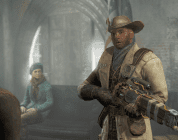Much like Power Rangers and Pokemon, I have a deep love of Digimon from my time spent watching the show each Saturday in the early 90s. While Pokemon continued to captivate me as a child with each release of the Game Boy games, I always felt more invested in the stories found in the Digimon show; the end of a story arch felt like an event that was built up by ads and special hour blocks. I’ve always wanted a Pokemon-like game in the Digimon universe and while I am nostalgic for many of the Digimon PlayStation games they never quite met the mark. Digimon Story Cyber Sleuth looked to be the answer to my prayers but there are several elements that cripple an otherwise well-designed and addictive RPG.
Digimon Story Cyber Sleuth: Complete Edition pairs together Cyber Sleuth and Hacker’s Memory. Because I had already spent plenty of time with Cyber Sleuth on the Vita, I chose to primarily play the sequel Hacker’s Memory for this review. Hacker’s Memory expands the monster offerings of the original game with a narrative running parallel to the original Cyber Sleuth and reusing many of those assets.
The Cyber Sleuth games ape the popular Persona series in style and layout. Players spend their time completing simple quests, running around a digital world called Eden, and raising hundreds of Digimon. The story involves dealing with several hacker factions and the moral questions their practices can raise, often bringing up some mature themes. This is all on the most surface of levels though, as the game’s simple and repeating lines of dialogue just don’t carry any weight. I rarely connected with the game’s narrative, a shame since these games are so clearly inspired by a story-driven franchise.
As a quality of life feature, I would have loved to see a skip dialogue option or an auto-scroller.
So if half of the game’s content is dull dialogue and reused assets why have I spent hundreds of hours between the two? I like monster-raising RPGs and Digimon Story Cyber Sleuth has an addictive combat system at its core. Battles are similar to the mainline Pokemon games in that Digimon come in various types and fight in turn-based encounters. Each creature is one of four types (Data, Virus, Vaccine, or Free) combined with an Attribute (Neutral, Fire, Water, Wind, Earth, Plant, Electric, Dark, or Light) as well as their stage (Training I, Training II, Rookie, Champion, Ultimate, or Mega) with each having a Memory Use that determines the amount that can be used in a party. Having Digimon at a lower stage can mean having more Digimon in a party. Digimon can also Armor Digivolve, DNA Digivolve, etc to create even stronger monsters and variants. There are 341 Digimon to collect and train in Hacker’s Memory and 249 in Cyber Sleuth with many branching evolution paths to explore.
There are various battle strategies to explore with buffs, debuffs, and status ailments but for the most part, it’s all about hitting weaknesses by having lots of different types of attacks. Each Digimon gets one or two signature attacks with a quick and crisp animation as well as five skills that can be exchanged between fourteen banked skills. Learning more moves than that will prompt the tamer to choose a move to lose, much like Pokemon. Digimon can also be given equipment for various stat bonuses, protections, and buffs. Lastly, accessories can be earned in the online arena (which thankfully has an NPC match option because not many players are using this mode) which can add some visual flair to the creature like a hat.
Combat is snappy and can be made even quicker by turning off battle animations. Because of this speed and the ability to just spawn a combat encounter using a hacker skill (skills that offer increased movement speed, fewer encounters, based on the types of Digimon in a party) grinding levels and getting more and more digivolution options is rewarding and fun. That said, it takes a long time to be able to fight high enough level Digimon to get a good amount of experience points and this makes the game’s encounters really easy. I only failed to beat my opponents once in the arena. Other than this moment I steamrolled everything in my way.
I can’t stress enough how addictive the combat is in these games; it’s the perfect thing to do while watching a movie or listening to a podcast. Those who do take the time to beat Cyber Sleuth also get bonuses when starting Hacker’s Memory and I was also given some extra chibi Digimon just for starting Hacker’s Memory outright. Yet, unless the extra bonuses and knowing the full story is appealing to the player, there isn’t much of a reason to start with Cyber Sleuth, even though I found that cast of characters more interesting. Erika, a character that suffers from a brain disorder that forces her to constantly upload memories to a server, is the only genuinely intriguing character I’ve run into so far in Hacker’s Memory.
Because Hacker’s Memory runs parallel to Cyber Sleuth just about every area is recycled. Environments are small and boring with not a whole lot to do aside from buying some items, taking part in a tournament, or collecting Digimon medals which can only be looked at when talking to a specific character. Quests usually spawn a character to talk to in one of Japan’s city districts or in the digital world of Eden. Almost every task can be boiled down to these steps: find a character, have a long and boring chat, go through the same dungeon over and over, fight a boss, sometimes get the same dialogue recapped at the end of the quest, and repeat. I was really disappointed to be going through the same areas I had before and those areas are so small and unassuming that it seems like such a waste. I miss the larger and more detailed areas of Digimon World and Digimon World 3.
The pacing, aside from the combat, is painfully slow and repetitive in the worst ways. This game really should have pulled more from Persona to make these characters feel more meaningful. As it stands, we just get a bunch of flat characters running around as hackers just solving basic, empty problems. The writing is usually just a collection of throwaway lines too.
Thankfully, the Digimon look awesome, are fun to battle and have enough facets that they are addictive to raise. I would really love to see this combat system in a third entry with better levels, more complex characters, and good writing that ties it all together. It’s great to see both games packaged together for a single price but they are so similar that I can’t imagine playing through both of them all the way through.
Regardless, I am excited for the future of the Digimon franchise and I’m eager to play the upcoming strategy RPG, Digimon Survive, which also appears to have a more mature tone overall.
More information about Digimon Story Cyber Sleuth: Complete Edition can be found on the official website. The game is available on Nintendo Switch and Steam for $49.99 USD. A digital Switch copy of the game was provided for the purpose of review. For another review from a 90s franchise, check out my thoughts on the 3v3 fighter Power Rangers: Battle for the Grid.





